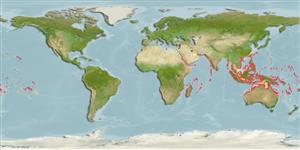Common names from other countries
Environment: milieu / climate zone / depth range / distribution range
Écologie
Récifal; non migrateur (Ref. 348); saumâtre; profondeur 0 - 35 m (Ref. 348). Tropical; 23°C - 30°C (Ref. 102835); 28°N - 37°S, 31°E - 128°W
Indo-Pacific: Egypt to Pitcairn Islands and Ogasawara, Japan to Lord Howe Island.
Length at first maturity / Taille / Poids / Âge
Maturity: Lm ?, range 6 - 13 cm Max length : 41.7 cm SHL mâle / non sexé; (Ref. 117184); common length : 25.0 cm SHL mâle / non sexé; (Ref. 348)
Description synthétique
Morphologie
The mantle color is highly variable, ranging from bright blue to brown.
Collected for food and for the shell trade. Aquaculture trials have been done in 1998 (Ref. 348). Maximum depth from Ref. 75831. Found in coral reef flats in shallow areas (Ref. 799), reef areas of lagoons (Ref. 97298) and in intertidal areas (Ref. 75831). Mixotrophic - filter feeds and photosynthesizes via its zooxanthellae (Ref. 105208). Tridacnids derive their nutrition from uptake of dissolved matter through their epidermis and from their symbiotic zooanthella Symbiodinium microadriaticum (Ref. 107098).
Life cycle and mating behavior
Maturité | Reproduction | Frai | Œufs | Fécondité | Larves
Life cycle: Embryos develop into free-swimming trocophore larvae, succeeded by the bivalve veliger, resembling a miniature clam (Ref. 833).
SAUP Database. 2006. (Ref. 356)
Statut dans la liste rouge de l'IUCN (Ref. 130435)
statut CITES (Ref. 108899)
Not Evaluated
Menace pour l'homme
Reports of ciguatera poisoning (Ref. 130160)
Utilisations par l'homme
Pêcheries: commercial
FAO - Aquaculture: production; | FishSource | Sea Around Us
Outils
Sources Internet
Estimates based on models
Preferred temperature
(Ref.
115969): 24.8 - 29.3, mean 28.4 (based on 3421 cells).
Résilience
Milieu, temps minimum de doublement de population : 1,4 à 4,4 années (K=0.18-0.28; tm=3.8).
Prior r = 0.49, 95% CL = 0.32 - 0.73, Based on 1 data-limited stock assessment.
Vulnérabilité
Low vulnerability (25 of 100).
Catégorie de prix
Unknown.
